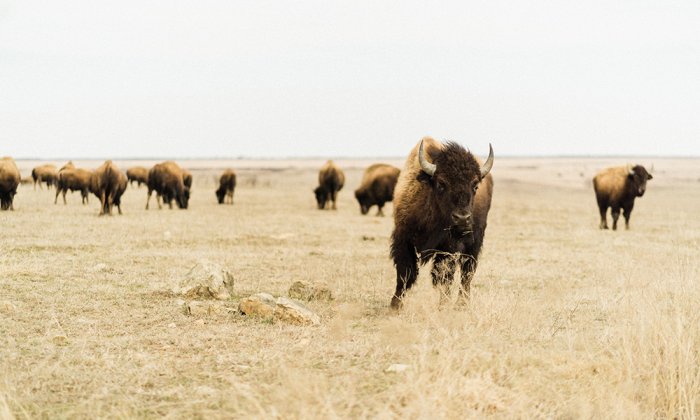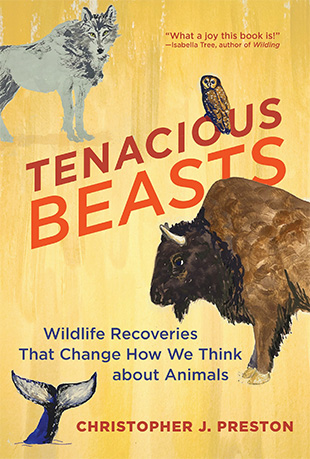Tenacious Beasts: In Conversation With Environmental Philosopher Christopher Preston

The news about wildlife is dire — more than 900 species have been wiped off the planet since industrialization. But against this bleak backdrop there are also glimmers of hope and crucial lessons to be learned from animals that have defied global trends toward extinction: bears in Italy, bison in North America, whales in the Atlantic. These populations are back from the brink, some of them in unimaginable numbers. How has this happened?

In his new book, “Tenacious Beasts,” environmental philosopher Christopher Preston reveals the mysteries and challenges at the heart of these resurgences. Drawing on compelling personal stories from the researchers, Indigenous people, and activists who know the creatures best, Preston weaves together a gripping narrative of how some species are taking back vital, ecological roles, and offers a road map for a future in which humans and animals can once again coexist.
The following discussion between Preston and writer Rebecca Foster was originally published by Foreword Reviews and is republished here with permission.
–The Editors
What sparked this book? Was it one moment — such as the time you describe in the first chapter when you saw two wolves from your car in rural Canada — or a series of questions and/or epiphanies?
In 2018, I wrote a book called “The Synthetic Age” about the takeover of the natural world by technology. As the book progressed, I could not shake the feeling that the biological world was a stubborn obstacle the takeover. Whether it was a genome that suddenly mutated under a scientist’s nose or a grizzly bear that charged an experienced hiker, the living world remains feisty. It has endless capacity to surprise. I wanted to dig into this a bit.
When Covid-19 locked us all in our homes, people were astonished to see wildlife reclaiming village squares, canals, and city streets. But perhaps this should not have been such a surprise. Wildlife are resilient. They wait in the wings for a chance to come back. In the midst of the biodiversity crisis, I felt it important to shine a light on these tenacious beasts. I thought of it as an opportunity to know the animals more intimately, to understand their potential, and to change some attitudes so the recoveries become more frequent.
What are your goals as an environmental philosopher? How do you see the field acting as a guide during escalating climate crisis?
Environmental philosophers try to think about the natural world in helpful ways. It’s important to scrutinize ideas from time to time to root out distorted thinking. An animal that recovers provides an opportunity to see it again with fresh eyes. We no longer have to default to the old myths. Ecological science has improved, our understanding of animal behavior is more sophisticated, and the tools at our disposal for cohabiting are much more effective. We can change how we think about animals.
The “big, bad wolf” is a case in point. There was one mindset for the 1850s. It lingered a while. A much more informed mindset is now emerging. We know the benefits of “top-down” regulation by predators in an ecological system. We appreciate the intelligence and pack dynamics of wolves. We understand more about how to get along with them. Oregon writer Barry Lopez said no animal carries around more of our psychic baggage than the wolf. We have jettisoned some of the baggage but there is further to go. “Tenacious Beasts” is written to help move the conversation along.
Rewilding has become such a buzzword, perhaps especially here in the UK (where you’re from, and I live). Will it just be a fad, or does the concept have staying power?
It’s unfortunate the word “rewilding” became so prominent so quickly. People saw an invitation to draw battle lines. I don’t think it’s helpful to frame it as a choice between people and nature. I prefer to talk about restoration and recovery. Who doesn’t approve of the idea of a recovery?
I have no doubt restoration and recovery are here to stay. In many cases, they offer multiple benefits. The bison recently returned to Blean Woods in the UK are a benefit to biodiversity, a benefit to the climate, and an economic opportunity for the local community. They also help cultivate a new — and enlivening — relationship with an old landscape, perhaps even providing a small boost to collective mental health. Imagine thinking of a bison not just as a shaggy charismatic beast but as an opportunity for personal growth!
“The ship is slowly turning towards the acceptance of sharing a landscape. Coexistence is a hot topic.”
There will always be landscapes in need of repair. There will always be wildlife waiting for an opportunity to return. Towards the end of “Tenacious Beasts,” I imagine a time when the human population has peaked and starts to decline. Technology has made many industrial processes more efficient and spaces on the map are starting to open up for recovery. What an exciting time that will be! And we don’t have to wait till 2064 (or whenever peak population occurs). Some recoveries are happening now. Let’s look at them, celebrate them, and see what must happen to help them spread.
The ongoing project can be framed in different ways: is rewilding more a matter of humans “playing god” (the overarching theme of your previous book), or of allowing nature to take back over?
I certainly would not characterize restoration and recovery as a matter of nature taking over. In most cases, we are talking about a future where humans and wildlife are figuring out new ways to exist on the landscape together. Here in the western United States, the environmental movement has been going through a solid reckoning with the idea of separating people and nature into entirely different realms. The ship is slowly turning towards the acceptance of sharing a landscape. Coexistence is a hot topic. And, of course, it is possible to live with a lighter touch. Indigenous leaders have provided plenty of inspiration here.
I would also shy away from the idea this involves playing God. It is true that some restorations require quite a bit of human management. Iberian lynx required intensive captive-breeding. Recovering California condors still have to visit the lab each year to have lead removed from their blood. Marsican bears need apple trees pruning so they have enough food in the Apennine hills. But other recoveries are completely hands-off. The wolf in Europe, the humpback whale across the world’s oceans, and the bobcat in New England simply showed up. All we had to do was to stop killing them and allow them a safe space to live. It was one of the profoundest — and most absurd — lessons in the book. All some animals need is to be left alone. Fancy that!
An author I follow online who is writing a book about wild boar in the UK finds that language is often a major problem — newspaper headlines will inevitably refer to “rampaging” boar, and focus on property damage. How does the way that we speak about animals need to change?
I saw that comment about boars always being portrayed as rampaging. It doesn’t really help to regurgitate the same old language. How dull! This gets us back to what philosophers can offer. They can look at concepts that seem dated and suggest better ones.
In my chapter on humpback whales, I travel to Alaska to meet with Heidi Pearson, a marine mammal behavioral ecologist who is interested in blue carbon. This is the study of how the marine environment can help with carbon sequestration. It turns out whales may have something to offer here by moving nutrients around the ocean as they feed and excrete. Those nutrients can provide a boost to carbon sequestration. (It’s explained in the book!).
If whales really do help with carbon sequestration, why not think of them as allies in the climate change battle? Yes, they are smart. Yes, they are charismatic. But they are also allies and partners. We need them on our side during the climate crisis.
Similarly, when we seek to restore rivers, we need to learn from the real experts in river restoration, beavers. We should apprentice ourselves to them. A whole industry of building fake beaver dams — called BDAs or beaver dam analogues — has evolved. We are learning a set of skills from beavers. Ideas like partnership and apprenticeship seem helpful. As we learn more about ocean ecology and river restoration, we uncover more interesting ways to think about animals.
Give us some examples of how cultural values affect how different countries view reintroduced or returning species. Is a younger country like the USA more prone to frontier myths, and are these generally helpful or the opposite?
In the chapter on the return of European wolves, a Belgian friend told me the Flemish are much more freewheeling about life than their neighbors, the Dutch. They admire a rugged individual who crosses boundaries and takes a risk. In this friend’s view, the Belgians would be much more enthusiastic about the return of the wolf than the Dutch. They would admire the wolf’s courage and independence.
In the western Rocky Mountain states, ranching can sometimes look quite similar to how it looked a century ago. There is some rich history here. But the idea that wolves and bison have to make way for people is not uncommon, even today. At the same time, there is a lot of love for wildlife in these places. Working ranches are a stout defense against land being cut up for development. There is a tremendous opportunity to build alliances between ranchers and wildlife advocates. When you sit around the same table, there are more common values than differences. It’s delicate, but you can get things done.
“If you think of whales as partners in the task of tackling carbon or beavers as teachers in how to store water, you are echoing how tribal people think of these animals.”
In several of the stories I tell, Indigenous people have illuminated the paths towards recovery and cohabitation. During the Elwha Dam removal on the Olympic Peninsula, the bison reintroduction on the Rocky Mountain Front, and the sea otter recovery in Southeast Alaska, Indigenous people took the lead. The Lower Elwha Klallam, the Blackfeet, the Salish, and the Tlingit people are making things happen while showcasing better ways to think about animals. If you think of whales as partners in the task of tackling carbon or beavers as teachers in how to store water, you are echoing how tribal people think of these animals.
The focus here is on charismatic megafauna like bears, bison, whales, and wolves. But, of course, species recovery can also be on a small scale, involving invertebrates (as at Blean Woods), or very local patches. How would you like to see such stories publicized, or new opportunities for participation made available to laymen?
Stan Smith at Blean Woods left a real impression on me when he spoke about his goals for creating bioabundance. Of course, the elephants in the room (…ahem…) were the bison that Stan was about to bring back. But Stan was just as enthusiastic about spiders, rare plants, and woodpeckers. I like the idea of focusing on bioabundance and not on a particularly heroic species. In fact, I got called out twice — once by Jake Fiennes on the Holkham Estate and once by Wouter Helmer, former director of Rewilding Europe — for being a little too focused on the megafauna. Lesson learned!
We need beautiful storytellers to help us celebrate the different layers of biodiversity. People like me need to be put out to pasture if I harp on too much about the big beasts. Spiders and weevils are tenacious, too!
You acknowledge that the overall picture is bleak for the world’s wildlife, but still hold that celebrating these successes is valuable. How do you hope that your book will inspire readers and activists, and be part of a positive movement?
I remember having a bit of an epiphany about climate change when Missoula, MT, got its first electric buses. As I came alongside one at a traffic light on my bike, it struck me just how great these buses were. There was no noisy diesel engine rumbling in my ear, no cloud of particulates choking up the air. There was just a gentle hiss of air and a whirr of motion when the light turned green and bus took off. Who wouldn’t want this for their hometown?
I feel the same way about wildlife recoveries. You need a vision of a better world to be motivated to get there. You need to feel the power of that future. Not a word of what I write in “Tenacious Beasts” casts doubt on the severity of the biodiversity crisis. It’s real and we should be alarmed by it. But l wanted to flip the script for a moment and see what we can learn from the good news. What might an alternative future look like? I try to offer an exciting taste of it in the book. The biodiversity crisis is real. But the glimmers of hope are real, too. Let’s take a moment to nourish ourselves with them.
Rebecca Foster is a full-time freelance proofreader and writer. Her book reviews regularly appear in many print and online locations on both sides of the Pond, including the Times Literary Supplement and the Pittsburgh Post-Gazette.
This discussion originally appeared on Foreword Reviews and is republished here with permission.

